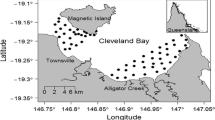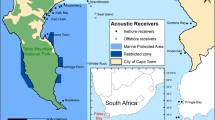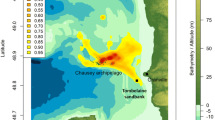Abstract
Wildlife tourism has become increasingly popular and is one of the fastest growing sectors of the tourism industry. A radio-acoustic positioning system was deployed to monitor the fine-scale movements of 21 white sharks (Carcharodon carcharias) and investigate the effects of shark cage-diving activities on their swimming behaviour and space use. This study contributes towards improving our understanding of the complex relationship between wildlife tourism and its effects on sharks, and assesses how tourism targeting sharks affects behaviour at a finer spatial scale than previously investigated. Our study demonstrated that shark cage-diving operators (SCDO) influenced the fine-scale three-dimensional spatial distribution and the rate of movement of white sharks at the Neptune Islands. White sharks stayed more than 30 m away from the SCDO on 21 % of the days detected, but spent a significant amount of time in close proximity to the SCDO on the remaining days. Individual variation was detected, with some sharks behaviourally responding to SCDO more than others. The degree of variation between individual sharks and the different levels of interaction (e.g. presence, proximity to SCDO, and consumption of tethered bait) highlights the complexity of the relationships between SCDO and the effects on sharks. To improve our understanding of these relationships, future monitoring of shark cage-diving operations requires proximity to SCDO to be recorded in addition to the presence within the area. Further work is needed to assess whether the observed behavioural changes would affect individual fitness and ultimately population viability, which are critical information to unambiguously assess the potential impacts of wildlife tourism targeting sharks.








Similar content being viewed by others
References
Ballantyne R, Packer J, Hughes K, Dierking L (2007) Conservation learning in wildlife tourism settings: lessons from research in zoos and aquariums. Environ Educ Res 13:367–383
Barker SM, Peddemors V, Williamson JE (2011a) Recreational SCUBA diver interactions with the critically endangered Grey Nurse Shark. Pac Conserv Biol 16:261–269
Barker SM, Peddemors V, Williamson JE (2011b) A video and photographic study of aggregation, swimming and respiratory behaviour changes in the Grey Nurse Shark (Carcharias taurus) in response to the presence of SCUBA divers. Mar Freshw Behav Physiol 44:75–92
Barnett A, Abrantes K, Stevens J, Bruce B, Semmens JM (2010) Fine-Scale movements of the broadnose sevengill shark and its main prey, the gummy shark. PLoS ONE 5:e15464
Bejder L, Samuels A, Whitehead H, Gales N, Mann J, Connor R, Heithaus M, Watson-Capps J, Flaherty C, Krutzen M (2006) Decline in relative abundance of bottlenose dolphins exposed to long-term disturbance. Conserv Biol 20:1791–1798
Bonfil R, Meyer M, Scholl MC, Johnson R, O’Brien S, Oosthuizen H, Swanson S, Kotze D, Paterson M (2005) Transoceanic migration, spatial dynamics, and population linkages of white sharks. Science 310(5745):100–103
Boustany AM, Davis SF, Pyle P, Anderson SD, Le Boeuf BJ, Block BA (2002) Expanded niche for White Sharks. Nature 415:35–36
Bruce BD, Bradford RW (2012) Spatial dynamics and habitat preferences of juvenile white sharks in eastern Australia. In: Domeier ML (ed) Global Perspectives on the biology and life history of the great white shark. CRC Press, Boca Raton, pp 225–254
Bruce BD, Bradford RW (2013) The effects of shark cage-diving operations on the behaviour and movements of white sharks, Carcharodon carcharias, at the Neptune Islands, South Australia. Mar Biol 160:889–907
Bruce BD, Stevens JD, Bradford RW (2005) Site fidelity, residence times and home range patterns of white sharks around pinniped colonies. Australian Government Department of Environment and Heritage, Hobart
Bruce BD, Stevens JD, Malcolm H (2006) Movements and swimming behaviour of white sharks (Carcharodon carcharias) in Australian waters. Mar Biol 150:161–172
Brunnschweiler JM, Barnett A (2013) Opportunistic visitors: long-term behavioural response of bull sharks to food provisioning in Fiji. PLoS ONE 8:e58522
Buckley R (2004) Impacts of ecotourism on birds. In: Buckley R (ed) Environmental impacts of ecotourism. CAB International, Cambridge, pp 187–209
Calow P (1979) Adaptive aspects of energy allocation. In: Tyler P, Calow P (eds) Fish energetics: new perspectives. Croom Helm, Kent, pp 13–32
Carey FG, Kanwisher JW, Brazier O, Gabrielson G, Casey JG, Pratt HLJ (1982) Temperature and activities of white shark, Carcharodon carcharias. Copeia 1982:254–260
Christiansen F, Lusseau D, Stensland E, Berggren P (2010) Effects of tourist boats on the behaviour of Indo-Pacific bottlenose dolphins off the south coast of Zanzibar. Endanger Species Res 11:91–99
Clua E, Buray N, Legendre P, Mourier J, Planes S (2010) Behavioural response of sicklefin lemon sharks Negaprion acutidens to underwater feeding for ecotourism purposes. Mar Ecol Prog Ser 414:257–266
Culik BM (1994) Energy requirements of Pygoscelid penguins: a synopsis. Rep Polar Res 150:1–76
DEWHA (2010) Draft recovery plan for the conservation and management of White Sharks (Carcharodon carcharias). Department of the Environment, Water, Heritage and the Arts, ACT
Domeier ML, Nasby-Lucas N (2008) Migration patterns of white sharks Carcharodon carcharias tagged at Guadalupe Island, Mexico, and identification of an eastern Pacific shared offshore foraging area. Mar Ecol Prog Ser 370:221–237
Domeier ML, Nasby-Lucas N, Lam CH (2012) Fine-scale habitat use by white sharks at Guadalupe Island, Mexico. In: Domeier ML (ed) Global perspectives on the biology and life history of the white shark. CRC Press, Boca Raton, pp 121–132
Driscoll JW (1995) Attitude toward animals: species ratings. Soc Anim 3:139–150
Duchesne M, Cote SD, Barette C (2000) Responses of woodland caribou to winter ecotourism in the Charlevoix Biosphere Reserve, Canada. Biol Conserv 96:311–317
Duffus DA, Dearden P (1990) Non-consumptive wildlife oriented recreation: a conceptual framework. Biol Conserv 53:213–231
Duffy C, Francis MP, Manning MJ, Bonfil R (2012) Regional population connectivity, oceanic habitat, and return migration revealed by satellite tagging of white sharks, Carcharodon carcharias, at New Zealand aggregation sites. In: Domeier ML (ed) Global perspectives on the biology and life history of the white shark. CRC Press, Boca Raton, pp 301–318
Fay MP (2010) Two-sided exact tests and matching confidence intervals for discrete data. R J 2:53–58
Ferguson K (2006) Submerged realities: shark documentaries at depth. Atenea 26:115–129
Fitzpatrick R, Abrantes KG, Seymour J, Barnett A (2011) Variation in depth of whitetip reef sharks: does provisioning ecotourism change their behaviour? Coral Reefs 30:569–577
Giese M, Handsworth R, Stephenson R (1999) Measuring resting heart rates in penguins using an artificial egg. J Field Ornithol 70:49–54
Gosling S (2001) From mice to men: what can we learn about personality from animal research. Psychol Bull 127:45–86
Green R, Giese M (2004) Negative effects of wildlife tourism on wildlife. In: Higginbottom K (ed) Wildlife tourism: impacts, management and planning. Sustainable Tourism Cooperative Research Centre, Gold Coast, pp 81–97
Green RJ, Higginbottom K (2001) Status assessment of wildlife tourism in Australia series: the negative effects of wildlife tourism on wildlife. Wildlife Tourism Research Report CRC for Sustainable Tourism, Gold Coast, Queensland
Higginbottom K, Tribe A (2004) Contributions of wildlife tourism to conservation. In: Higginbottom K (ed) Wildlife tourism: impacts, management and planning. Common Ground Publishing, CRC for Sustainable Tourism, Gold Coast, pp 99–123
Iosilevskii G, Weihs D (2008) Speed limits on swimming of fishes and cetaceans. J R Soc 5:329–338
Jorgensen SJ, Reeb CA, Chapple TK, Anderson SP, Van Sommeran SRF-C, Brown AC, Klimley AP, Block BA (2009) Philopatry and migration of Pacific White Sharks. Proc R Soc B Biol Sci 277:679–688
Kerbiriou C, Le Viol I, Robert A, Porcher E, Gourmelon F, Julliard R (2009) Tourism in protected areas can threaten wild populations: from individual response to population viability of the chough Pyrrhocorax pyrrhocorax. J Appl Ecol 46:657–665
Klimley A, Le Boeuf B, Cantara K, Richert J, Davis S, Van Sommerman S (2001a) Radio acoustic positioning as a tool for studying site-specific behavior of the white shark and other large marine species. Mar Biol 138:429–446
Klimley AP, Le Boeuf BJ, Cantara K, Richert J, Davis SF, Van Sommerman S, Kelly JT (2001b) The hunting strategy of white sharks (Carcharodon carcharias) near a seal colony. Mar Biol 138:617–636
Klimley AP, Beavers SC, Curtis TH, Jorgensen SJ (2002) Movements and swimming behavior of three species of sharks in La Jolla Canyon, California. Environ Biol Fishes 63:117–135
Knight RL, Cole DN (1995) Factors that influence wildlife responses to recreationists. In: Knight RL, Gutzwiller KJ (eds) Wildlife and recreationists: coexistence through management and research. Island Press, Washington, pp 71–80
Koolhaas J, Korte S, De Boer S, Van Der Vegt B, Van Reenen C, Hopster H, De Jong I, Ruis M, Blokhuis H (1999) Coping styles in animals: current status in behavior and stress-physiology. Neurosci Behav Rev 23:925–935
Laroche KR, Kock AA, Dill LM, Oosthuizen H (2007) Effects of provisioning ecotourism activity on the behaviour of white sharks Carcharodon carcharias. Mar Ecol Prog Ser 338:199–209
Laroche KR, Kock AA, Dill LM, Oosthouizen WH (2008) Running the gauntlet: a predator-prey game between sharks and two age classes of seals. Anim Behav 76:1901–1917
Le Boeuf BJ (2004) Hunting and migratory movements of white sharks in the eastern North Pacific. Memoirs Natl Inst Polar Res 58:89–100
Lott D, McCoy M (1995) Asian Rhinos Rhinoceros unicornis on the run? Impact of tourist visits on one population. Biol Conserv 73:23–26
Lusseau D, Bain D, Williams R, Smith J (2009) Vessel traffic disrupts the foraging behavior of southern resident killer whales Orcinus orca. Endanger Species Res 6:211–221
Lynch A-MJ, Sutton SG, Simpfendorfer CA (2010) Implications of recreational fishing for elasmobranch conservation in the Great Barrier Reef Marine Park. Aquat Conserv 20:312–318
Maljković A, Côté I (2011) Effects of tourism-related provisioning on the trophic signatures and movement patterns of an apex predator, the Caribbean reef shark. Biol Conserv 144:859–865
Martin JGA, Réale D (2008) Animal temperament and human disturbance: implications for the response of wildlife to tourism. Behav Process 77:66–72
Martin RA, Rossmo DK, Hammerschlag N (2009) Hunting patterns and geographic profiling of white shark predation. J Zool 279:111–118
Meyer CG, Dale JJ, Papastamatiou YP, Whitney NM, Holland KN (2009) Seasonal cycles and long-term trends in abundance and species composition of sharks associated with cage diving ecotourism activities in Hawaii. Environ Conserv 36:104–111
Newsome D, Dowling R, Moore S (2005) Wildlife tourism. Channel View, Clevendon
O’Dor RK, Andrade Y, Webber D, Sauer W, Roberts M, Smale M, Voegeli F (1998) Applications and performance of Radio-Acoustic Positioning and Telemetry (RAPT) systems. Hydrobiologia 371:3721–3728
Orams M (2002) Feeding wildlife as a tourism attraction: a review of issues and impacts. Tour Manage 23:281–293
Robbins RL (2007) Environmental variables affecting the sexual segregation of great white sharks Carcharodon carcharias at the Neptune Islands, South Australia. J Fish Biol 70:1350–1364
Roes D, Leader-Williams N, Dalal-Clayton B (1997) Take only photographs, leave only footprints: the environmental impacts of wildlife tourism. International Institute for Environment and Development Wildlife and Development Series, vol 10. International Institute for Environment and Development, London
Scheyvens R (1999) Ecotourism and the empowerment of local communities. Tour Manage 20:245–249
Semeniuk CAD, Speers-Roesch B, Rothley KD (2007) Using fatty-acid profile analysis as an ecologic indicator in the management of tourist impacts on marine wildlife: a case of stingray-feeding in the Caribbean. Environ Manag 40:665–677
Semmens JM, Payne N, Huveneers C, Sims DW, Bruce BD (2013) Feeding requirements of white sharks may be higher than originally thought. Sci Rep 3:1471
Shackley M (1996) Wildlife tourism. International Thomson Business Press, London
Shaughnessy PD, McKeown A (2002) Trends in abundance of New Zealand fur seals, Arctocephalus fosteri, at the Neptune Islands, South Australia. Wildl Res 29:363–370
Sih A, Bell A, Johnson JC (2004) Behavioral syndromes: an ecological and evolutionary overview. Trends Ecol Evol 19:372–378
Smith K, Scarr M, Scapaci C (2010) Grey nurse shark (Carcharias taurus) diving tourism: tourist compliance and shark behaviour at Fish Rock, Australia. Environ Manag 46:699–710
Steven R, Pickering C, Castley JG (2011) A review of the impacts of nature based recreation on birds. J Environ Manag 92:2287–2294
Strong WR, Murphy RC, Bruce BD, Nelson DR (1992) Movements and associated observations of bait-attracted white sharks, Carcharodon carcharias: a preliminary report. Aust J Mar Freshw Res 43:13–20
Strong WR, Bruce BD, Nelson DR, Murphy RD (1996) Population dynamics of white sharks in Spencer Gulf, South Australia. In: Klimley AP, Ainley DG (eds) Great white sharks: the biology of Carcharadon carcharias. Academic, San Diego, pp 401–414
Techera EJ, Klein N (2011) Fragmented governance: reconciling legal strategies for shark conservation and management. Mar Policy 35:73–78
Wearing S, Neil J (2009) Ecotourism: impacts, potentials, and possibilities, 2nd edn. Butterworth-Heinemann, Oxford
Weng KC, Boustany AM, Pyle P, Anderson SD, Brown A, Block BA (2007) Migration and habitat of white sharks (Carcharodon carcharias) in the eastern Pacific Ocean. Mar Biol 152:877–894
Williams R, Lusseau D, Hammond P (2006) Estimating relative energetic costs of human disturbance to killer whales (Orcinus orca). Biol Conserv 133:301–311
Worlf ID, Croft DB (2010) Minimizing disturbance to wildlife by tourists approaching on foot or in a car: a study of kangaroos in the Australian rangelands. Appl Anim Behav Sci 126:75–84
Zamora L, Moreno-Amich R (2002) Quantifying the activity and movement of perch in a temperate lake by integrating acoustic telemetry and a geographic information system. Hydrobiologia 483:209–218
Acknowledgments
This project was carried out under the Department of the Environment and Natural Resources permit number M25738 and M25738-2, and PIRSA Exemption number 9902364. Tagging was undertaken under Flinders University ethics approval number E287, while the VRAP system was operated under the radio licence number 1917458 provided by the Australian Communications and Media Authority. This project was funded by the Winifred Violet Scott Charitable Trust, Neiser Foundation, Wildlife Conservation Fund, Nature Foundation of South Australia, and Solar Online. This research was also partly supported under the Australian Research Council’s Discovery Projects funding scheme (project number DP0988554; www.arc.gov.au). Professor Seuront is the recipient of an Australian Professorial Fellowship (project number DP0988554). The authors would like to thank A. Fox, J. Taylor, and R. Robbins from Rodney Fox Shark Expeditions, and A. Wright and crew from Calypso Star Charters for providing invaluable logistic support and advice during this study. We thank H. Pederson and W. Gillepsie from Eonfusion, Myriax, for their effort and support with the data manipulation and analysis. A. Lowther and S. Kim helped with the time-spent-in-area calculation, GAMM analyses, and statistical interpretation.
Author information
Authors and Affiliations
Corresponding author
Additional information
Communicated by S. Connell.
Electronic supplementary material
Below is the link to the electronic supplementary material.
Rights and permissions
About this article
Cite this article
Huveneers, C., Rogers, P.J., Beckmann, C. et al. The effects of cage-diving activities on the fine-scale swimming behaviour and space use of white sharks. Mar Biol 160, 2863–2875 (2013). https://doi.org/10.1007/s00227-013-2277-6
Received:
Accepted:
Published:
Issue Date:
DOI: https://doi.org/10.1007/s00227-013-2277-6




